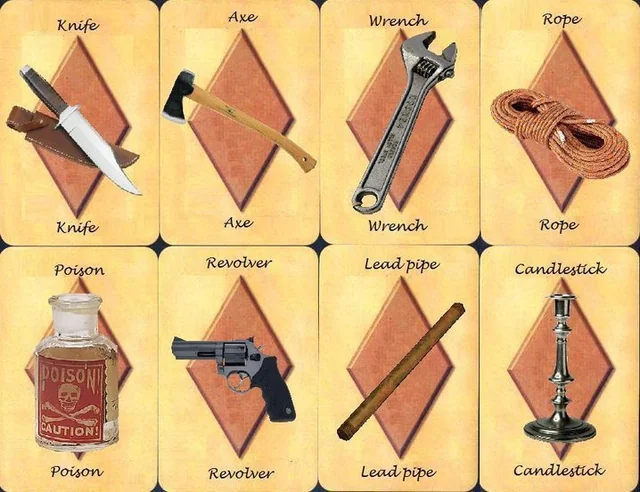
In the Shadows of Tudor Mansion: The Untold Stories of Clue Weapons
In the realm of classic board games, few can match the timeless allure of Clue. A murder mystery that has captivated generations since its inception in 1949, Clue transports players to the opulent Tudor Mansion, challenging them to unravel the enigma of a heinous crime. Central to the intrigue are the infamous Clue weapons, each with its unique history and significance in the game. In this exploration of The Game of Clue, we delve into the behind-the-scenes details of Clue weapons, uncovering the secrets that make this classic board game an enduring favorite.
The Origins of Clue
Before we delve into the weapons, let’s take a moment to appreciate the genesis of Clue. Created by Anthony E. Pratt during World War II, the game was initially named “Murder!” and underwent several modifications before Parker Brothers officially released it as Clue in 1949. The game’s premise revolves around players assuming the roles of suspects investigating a murder at Tudor Mansion, deducing the murderer, weapon, and location through strategic questioning.
Clue Weapons – The Arsenal of Intrigue
The allure of Clue lies not only in its compelling narrative but also in the diverse array of weapons that players can wield as they navigate the mansion’s shadowy corridors. The six classic Clue weapons are the Candlestick, Knife, Lead Pipe, Revolver, Rope, and Wrench. Each weapon serves as a pivotal element in the unfolding drama, leaving players to speculate on their significance.
- The Candlestick
The seemingly innocuous candlestick takes on a sinister persona in the world of Clue. Made of brass and often adorned with intricate designs, this weapon has a surprising weight to it, making it a formidable choice for the murderer. Its role in the game taps into the classic murder mystery aesthetic, evoking the image of candlelit rooms and clandestine meetings.
- The Knife
A staple of crime fiction, the Knife in Clue is a chilling reminder of the potential for violence within the confines of Tudor Mansion. Its inclusion as one of the Clue weapons adds a visceral edge to the game, prompting players to envision the stark reality of a deadly confrontation. The Knife’s simplicity belies its narrative impact, making it a timeless choice for any murder mystery enthusiast.
- The Lead Pipe
With its industrial aesthetic, the Lead Pipe introduces an element of blunt force trauma to the Clue narrative. The weapon’s weight and shape become crucial considerations for players trying to reconstruct the crime. The Lead Pipe’s inclusion demonstrates Clue’s commitment to offering a diverse array of weapons, each with its own distinct characteristics and implications.
- The Revolver
The Roaring Twenties backdrop of Clue’s Tudor Mansion sets the stage for the inclusion of the Revolver as one of the game’s weapons. This firearm adds a layer of danger and intrigue, reflecting the tumultuous era of its origin. The Revolver’s role in Clue is not just as a tool of murder but also as a symbol of the societal upheavals that defined the early 20th century.
- The Rope
The Rope in Clue evokes a sense of mystery and danger, harkening back to classic detective novels and films. Its inclusion as one of the Clue weapons introduces a strategic element, as players must consider the logistics and planning involved in using a rope to commit the crime. The Rope’s versatility adds complexity to the game, challenging players to think beyond conventional means.
- The Wrench
Completing the ensemble of Clue weapons is the Wrench, an unexpected yet effective choice for a murder weapon. The mechanical connotations of the Wrench add an element of industrial intrigue, hinting at motives beyond personal animosities. The inclusion of the Wrench showcases Clue’s commitment to keeping players on their toes, never allowing them to settle into comfortable assumptions.
The Symbolism of Clue Weapons
Beyond their practical role in the game, each Clue weapon carries symbolic weight, contributing to the immersive experience of solving a murder mystery. The Candlestick represents the hidden truths illuminated by careful investigation, while the Knife embodies the raw, unbridled violence that permeates the criminal underworld.
The Lead Pipe serves as a metaphor for the blunt realities of life, where actions have direct and immediate consequences. The Revolver stands as a testament to the volatile nature of the times, where power struggles and conflicts often escalated to deadly proportions.
The Rope introduces an element of calculated planning, reflecting the meticulous nature of a well-thought-out crime. Finally, the Wrench symbolizes the unexpected twists and turns inherent in any murder mystery, challenging players to adapt and revise their theories as new information emerges.
Conclusion
The Game of Clue stands as a testament to the enduring appeal of classic board games, and its arsenal of weapons plays a pivotal role in shaping the narrative and gameplay. The careful selection and design of Clue weapons offer players a rich and immersive experience, prompting them to engage not only in deduction but also in the exploration of the darker facets of human nature.
As we unravel the mysteries behind the scenes of Clue, it becomes clear that the weapons are not just tools of murder; they are symbols that elevate the game to a level of sophistication and intrigue that has stood the test of time. In the dimly lit halls of Tudor Mansion, where secrets lurk around every corner, the Clue weapons continue to cast their enigmatic shadows, inviting players to step into a world where solving a murder is both a challenge and a timeless adventure.



